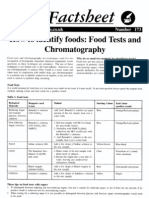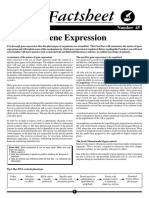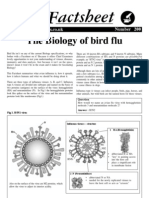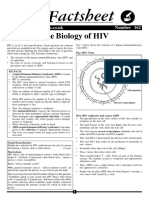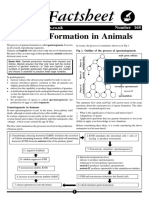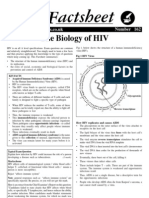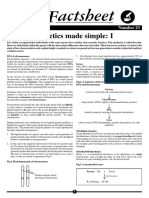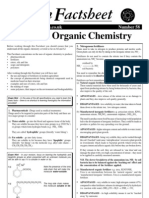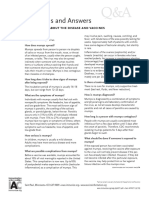099 - Vaccines
099 - Vaccines
Uploaded by
Arjan LallCopyright:
Available Formats
099 - Vaccines
099 - Vaccines
Uploaded by
Arjan LallOriginal Description:
Copyright
Available Formats
Share this document
Did you find this document useful?
Is this content inappropriate?
Copyright:
Available Formats
099 - Vaccines
099 - Vaccines
Uploaded by
Arjan LallCopyright:
Available Formats
B io Factsheet
January 2002
Number 99
Vaccines
By studying this Factsheet the student should know and understand:
what a vaccine is and how vaccination can control disease;
why vaccination has eradicated smallpox but not salmonellosis,
cholera, malaria, measles or tuberculosis;
methods of vaccine production and administration;
the effectiveness and limitations of immunisation programmes,
including the herd effect;
the ethics of vaccination programmes.
toxoids which are modified toxins secreted by the disease causing
organisms. For example, the toxin released by the tetanus causing
bacterium, Clostridium tetani, can be extracted from bacterial cultures,
made harmless by treatment with formalin and, when injected into the
body, stimulates the B-lymphocytes to develop an immune response
and memory against tetanus bacteria. Modified diphtheria toxin is also
used to vaccinate against diphtheria.
non-virulent strains of the organism. For example, non-virulent strains
of Rubella virus are used to vaccinate against german measles.
Definitions
Antigen: Any substance that when introduced into, or present in, the
tissues or blood causes the formation of antibodies.
Antibody: A protein produced by certain cells of the body in the
presence of a specific antigen. The antibody combines with that antigen
to inhibit, neutralise or destroy it.
Vaccination(immunisation) is a process of making members of a
population immune to a particular disease-causing organism. It involves
injecting (inoculating) harmless forms of the disease-causing organism
into people so that their immune response to the organism is established.
genetically engineered (GE) antigens. For example, hepatitis B antigens
are genetically engineered and used in the hepatitis B vaccine.
live attenuated strains of the disease causing organism. Vaccines made
from dead organisms or from modified toxins carry no risk of the person
developing the disease as a result of vaccination. However, in some
cases immunity will only develop if the lymphocytes are stimulated
by live bacteria or viruses. In this case the live organisms used in the
vaccine must be made much less virulent than those caught in an infection.
Such organisms are said to be attenuated. This can be done by exposing
them to heat or chemical treatment, or by growing them in an unusual
host. For instance, the BCG (Bacille Calmette Guerin) vaccine against
tuberculosis is made from tuberculosis bacteria (Mycobacterium
tuberculosis) which have been grown in a horse from which they are
collected. The bacteria have no disease causing effects on the horse,
and, although alive in the vaccine, do not cause tuberculosis in the
human recipient. However, it still stimulates antibody production and
active immunity to tuberculosis. Injecting humans with dead tuberculosis
bacteria does not stimulate antibody formation.
The humoral immune response
This is due to a specific type of white blood cell (B-Iymphocyte) which is
found mainly in the lymph nodes and spleen. If an antigen comes into
contact with the B-Iymphocytes:
1. a few of them recognise the antigen as foreign and divide many times,
by mitosis. This produces a clone consisting of millions of genetically
identical B-Iymphocytes.
2. most of these differentiate into plasma cells.
3. the plasma cells migrate from the lymph nodes into the circulation and
tissues. There they produce large concentrations of antibody molecules
which will specifically, combine with the antigen molecules and
neutralise their effects.
4. the remaining cloned B-lymphocytes stay in the lymph nodes and
become memory cells. If the body is challenged by the same antigen at
a subsequent date, the memory cells recognise it and divide rapidly,
forming huge numbers of antibody-secreting plasma cells. The antigen
is then destroyed before an infection can be established.
Attenuated yellow fever virus for vaccination by injection is grown in
tissue culture as is Sabin attenuated polio virus which is given by mouth.
All of these vaccines contain antigens and so cause an immune response to
be established. The attenuated strains do not cause as severe an infection as
the normal microorganisms but do cause adequate immunological protection
to be developed. This immunity is long lasting, active immunity, because
immune memory cells are produced and stored.
The vaccine may be given to the patient, usually a child, by injection into
the skin layers, muscle or bloodstream, or via the mouth (oral vaccine). The
antigenic components of an oral vaccine can be absorbed through the
stomach wall and intestinal wall without damage.
Vaccination and how it works
About 60 vaccines are in common use across the world, giving some
protection against bacterial, viral, protozoal and helminthic (worm) diseases.
Vaccines can consist of:
dead organisms or parts of organisms (for example, viral coat proteins).
For example, bacteria can be grown in cultures and viruses can be
grown in suitable host cells (influenza virus is grown in hens eggs).
The bacteria or viruses are killed using chemicals, such as formalin, and
the vaccines are usually given by injection. Examples are anti-cholera
vaccine, typhoid vaccine, whooping cough vaccine and Salk anti-polio
vaccine. Influenza vaccine consists of several antigens isolated from
several strains of influenza virus.
Exam Hint: examiners often ask candidates to distinguish between
active and passive immunity. Passive immunity is described later in
the Factsheet. They also ask about naturally acquired immunity and
artificially acquired immunity. Naturally acquired immunity is obtained
by suffering from the disease; artificially acquired immunity is obtained
by vaccination.
Bio Factsheet
Vaccines
What influences the effectiveness of a vaccine?
Booster doses of anti-tetanus vaccine should be given every five years to
maintain full protection. Three spaced doses of DPT vaccine (diphtheria,
pertussis, tetanus) are given to young children, starting when the child is
four to six months old.
1. The dose of the vaccine
The strength of the immune protection (indicated by the concentration of
antibody produced in the blood) may be increased by giving booster doses of
the vaccine. The timing and number of the booster doses varies according to
the vaccine involved. The effect of giving a booster dose is illustrated in Fig 1.
2. The number of strains of the pathogen.
Many pathogenic bacteria and viruses contain several different strains of
the species. The vaccine should contain antigens from all the strains to be
fully protective. For example:
influenza virus regularly mutates, so altering its antigens. So influenza
vaccinations are repeated every year on susceptible people.
Salmonella sps (cause typhoid fever, paratyphoid fever and salmonellosis
food poisoning) live in the intestines of many different animals (for
example, chickens, cattle, sheep, pigs). Because of this they have
considerable variability in their genetical and antigenic structure. A killed
vaccine is available and may be used to give protection during epidemics,
but a proportion of treated infected people remain as reservoirs of the
organism, carrying Salmonella in their gall bladder and excreting the
organisms in urine and faeces.
Vaccines for malaria are available but tend to be given only to travellers
who are going to visit malarial areas. They are not very effective because
the malarial parasite, Plasmodium has several different species, each with
several different strains and with many different stages in the life cycle.
The species, strains and life cycle stages are all antigenically different.
Fig 1. The effect of a primary vaccination (inoculation) and a
secondary inoculation (booster dose).
primary vaccination
antibody leve l
primary response (antibody level in blood)
antibody level falls
to a non-immune
level
immune
non-immune
months
primary inoculation with antigens (vaccine)
3. Altered vaccines
Certain chemicals, known as adjuvants, may be added to the vaccine to
make weak antigens produce a stronger immune response. Examples of
adjuvants are aluminium phosphate, oligodeoxyribonucleotides, some
tumour extracts and a heat-labile (unstable) enterotoxin of Escherischia coli.
Secondary vaccination
secondary response (long lasting)
antibody leve l
primary response
Herd immunity
Effective widespread vaccination not only protects the individual but reduces
the frequency of disease in the population, because it results in a smaller
reservoir of the pathogenic organism in the population. Thus non-vaccinated
individuals are less likely to come into contact with the pathogen. This is
known as the herd effect or herd immunity. This operates particularly
well in affluent countries where the majority of the population are immunised.
In poorer, third world countries relatively few people are vaccinated and so
the herd effect does not occur. This is because:
1. The vaccine is expensive, for example, measles vaccine.
2. There is often a high population density and therefore a high transmission rate.
3. There are no vaccination programmes in place.
4. Health care programmes and monitoring of disease outbreaks may be
inadequate.
immune
non-immune
years
secondary inoculation with antigens (vaccine)
Table 1. Examples of vaccines in common use
Purpose
Type of vaccine
Given by:
Vaccines in wide-spread use:
BCG (antituberculosis)
antidiphtheria
anti whooping cough (pertussis)
antitetanus
antimeasles
antipoliomyelitis: Sabin
Salk
antirubella
attenuated bacteria
toxoid
dead bacteria
toxoid
attenuated virus
attenuated virus
dead virus
non-virulent virus
injection
injection
injection
injection
injection
oral (by mouth)
injection
injection
Vaccines given to people who are exposed to specific risk:
antityphoid
antimeningitis (bacterial)
anticholera
anti yellow fever
antirabies
anti hepatitis B
dead bacteria
dead bacteria
dead bacteria
attenuated virus
attenuated virus
GE antigens
injection
injection
injection
injection
injection
injection
Antisera for use after a person has been exposed to infection: (see passive immunity)
antirabies
antitetanus
specific antibodies
specific antibodies
injection
injection
It is not necessary for you to remember all of these examples but remember some, of each group, so that you can refer to them if necessary.
Bio Factsheet
Vaccines
Measles in a non-immunised individual is a killer disease, causes serious
long-term effects in survivors and is extremely infectious. Thus measles
epidemics should be avoided the risks of suffering and possibly
dying from measles in an epidemic is probably much greater than the
risk of suffering vaccine damage.
Remember : vaccination can completely eradicate disease. Smallpox
was eradicated by a very efficient, world-wide vaccination programme
by the late 1970s. It was successful because:
money, medical personnel and materials were supplied by the World
Health Organisation (WHO).
all babies were vaccinated in the first year of life.
all people passing from one country to another had to be vaccinated.
an efficient surveillance system was developed to detect new
outbreaks of the disease. These could then be isolated and dealt
with promptly. All contacts of the disease were traced and vaccinated.
smallpox virus only infects people so other animals were not
reservoirs of the virus.
A similar worry for parents occurred with the pertussis (whooping
cough) vaccine in the 1970s. Because of a slight chance that the
vaccinated child might suffer convulsions (short-term) after vaccination,
many parents failed to have their children vaccinated this led to
several epidemics of whooping cough many children ended up with
permanent with lung and heart damage and many babies died. Following
these epidemics, most parents took the decision that vaccination was
the safest option and this was ethically correct because it also protected
the population.
Passive immunity
Sometimes actual antibodies are injected into people to give instant, short
term, passive immunity. For example, tetanus antibodies can be injected
into a person who may have been infected with the bacterium Clostridium
tetani. The antibodies give protection against the live tetanus bacteria until
the persons active immune response develops. Rabies is another example.
Fig. 2. Antibody levels in passive immunity
Exam Hint: - examiners may ask data interpretation questions about
vaccination which will require you to apply your knowledge of the
principles and events of vaccination. It is important to read and assess
any data given carefully.
antibody leve l
antibody level falls as it is destroyed
by the liver and excreted
Practice Questions
immune
non-immune
1. Read through the following account and then answer the questions below.
In very rare cases, whooping cough vaccine has been said to cause
epileptic-seizures or brain damage and public knowledge of this led to a
decline in acceptance of vaccination in Britain.
It is important to state that the risks of vaccination are much less than the
risks of whooping cough. Prior to the introduction of the vaccine in 1957,
over 100,000 cases of childhood whooping cough were officially notified
each year, and many more occurred which were not notified. The death
rate was about 1 per 1000 overall, but the rate was far higher in children
under one year of age. By 1973 vaccination of 80% of children had led to
a reduction in annual notifications to about 2400 cases. But public anxiety
thereafter caused a drop to 30% acceptance and major epidemics occurred,
between 1977 and 1979, and 1981 to 1983. By 1986 the acceptance rate
of vaccination had risen to 67% and epidemics have not recurred.
antibody level falls
to a non-immune
level
weeks
injection of serum
containing specific antibodies
The serum containing the antibodies is obtained from other mammals (for
example, horses, rabbits, other humans) which have been infected with the
disease organisms and which thus have the antibodies in their blood serum.
a) What ethical dilemma faced parents when deciding whether to
have their children vaccinated against whooping cough?
2
b) Approximately how many children, in Britain, died per year from
whooping cough, prior to 1957?
1
c) What is the main ingredient of whooping cough vaccine?
1
d) Describe how whooping cough vaccine produces immunity. 5
e) Comment on the herd effect in the population in the years 1973
and 1980.
4
The ethics of vaccination programmes
There are several ethical or moral issues involved in vaccination programmes:
It seems unethical that millions of people worldwide die each year from
diseases which could be prevented by mass vaccination programmes.
Mass vaccination programmes are not in place because of:
1. economic poverty.
2. the failure of more affluent countries to fund programmes.
3. wars
Because the chances of vaccine damage occurring are probably greater in
some children, for example, children who suffer from asthma, or who
belong to a family with a history of epilepsy, it is ethically important to
identify these children and to refrain from giving them risky vaccinations,
providing the herd effect in the population is high.
2. a) With reference to protection against tetanus, distinguish between
artificially acquired active immunity and artificially acquired passive
immunity.
4
b) Explain what is meant by the term attenuated organism.
2
c) Why does immunisation against influenza need to be repeated each
year?
2
There is a moral dilemma with some vaccinations. Individuals should
be vaccinated to build up the herd effect which protects the
population. However, some vaccines pose a threat to individuals. For
example, it has been suggested that the MMR triple vaccine (measles,
mumps, rubella), may in a small number of cases cause catastrophic
effects in the recipient, such as severe autism (when the child becomes
severely withdrawn, divorced from reality, unable to communicate and
subject to severe rages) and Crohns disease (inflammation of the ileum).
Part of the problem seems to lie with the fact that the triple vaccine
challenges the babys developing immune system with three different
viral pathogens at the same time. Some parents and doctors prefer to
give the three pathogens as single vaccinations spread over time. This
means however, that the baby is exposed to foreign proteins three
times as frequently and thus has a greater risk of adverse reactions to
the proteins.
3. a) In 1797 Edward Jenner discovered that inoculation of people with
material from sores on the hand of cowpox sufferers (a mild, nonlethal disease) protected them from catching smallpox. This
discovery led to eventual widespread vaccination against smallpox.
Explain the biological basis of this.
5
b) How has it been possible to eliminate smallpox from the world
population?
6
c) Why is it almost impossible to eliminate malaria from the world
population?
6
Bio Factsheet
Vaccines
b) WHO provided money, vaccine and personnel for a world-wide
immunisation programme;
all babies vaccinated in the first year of life;
people had to be vaccinated against smallpox before travelling
between countries;
good surveillance system so that new outbreaks could be dealt
with quickly;
by isolation and treatment of sufferers;
by vaccination of contacts/surrounding population;
6
Answers
1. a) individual children stood a small chance of developing convulsions
after vaccination;
but it is important for all members of a population to be vaccinated
in order to develop herd immunity/reduce the reservoir of disease
causing organisms;
2
b) (approx) 100 deaths per annum;
c) dead bacteria;
1
c) Plasmodium/malarial parasite has several life cycle stages all with
different antigens;
these antigens are subject to frequent change due to gene mutations;
also several species of malarial parasite occur all with different
antigens;
each species also has several strains which are also antigenically
different;
ref to huge reservoir of all malarial species in many mammals and
birds;
thus even if all potential sufferers were vaccinated new mutant
strains would appear from the reservoir;
6
d) (some/B-) lymphocytes detect (dead whooping cough) bacteria as
foreign;
these lymphocytes divide many times by mitosis to produce a
clone;
cloned cells differentiate into plasma cells and memory cells;
plasma cells synthesize specific antibodies to whooping cough
antigens/bacteria;
memory cells retain memory of antigens and can respond rapidly
to a later infection;
ref booster doses of vaccine to enhance immunity;
max 5
e) herd effect was high in 1973 because 80% of children in the
population were vaccinated;
thus relatively few cases occurred/only 2400 cases occurred;
herd effect was low in 1980 because only 30% of children were
vaccinated;
thus reservoir of bacteria in population was high and epidemics
occurred;
4
2. a) artificially acquired means that vaccination/inoculation takes place/
material is injected into the body;
in active immunity tetanus toxoid/modified tetanus toxin is injected
into the body;
this provokes the bodys immune response so that antibodies and
memory cells are produced/gives long term protection;
in passive immunity anti-tetanus antibodies are injected into the
body to give short-term protection/protection for a few weeks;
4
b) an organism that is still alive but weakened/not capable of causing
infection;
due to having been cultured in an unusual environment/given heat/
chemical treatment;
2
c) influenza virus constantly mutates to produce new antigens/strains;
each years vaccine is produced from all the strains of influenza
present in the population at the current time;
2
3. a) Vaccinia/cowpox virus has similar antigens to smallpox virus;
inoculation with cowpox virus stimulated the bodys immune
response;
plasma cells would produce antibodies against the cowpox virus
destroying it;
memory cells would retain the immunological memory enabling
rapid production of plasma cells and antibody when exposed to a
second infection;
memory cells would be fooled into responding to smallpox antigens
due to their similarity to cowpox antigens;
5
Acknowledgements:
This Factsheet was researched and written by Martin Griffin
Curriculum Press, Unit 305B, The Big Peg, 120 Vyse Street, Birmingham. B18 6NF
Bio Factsheets may be copied free of charge by teaching staff or students,
provided that their school is a registered subscriber. No part of these Factsheets
may be reproduced, stored in a retrieval system, or transmitted, in any other
form or by any other means, without the prior permission of the publisher.
ISSN 1351-5136
You might also like
- The POISONED NEEDLE - Suppressed Facts About Vaccination, by Eleanor McBean, 1957Document283 pagesThe POISONED NEEDLE - Suppressed Facts About Vaccination, by Eleanor McBean, 1957webtrekker UKNo ratings yet
- Bio Factsheet: Answering Exam Questions On RespirationDocument4 pagesBio Factsheet: Answering Exam Questions On Respirationapi-213276898No ratings yet
- 215 Genetic Testing and Screening PDFDocument4 pages215 Genetic Testing and Screening PDFChui WaiNo ratings yet
- Biofact Sheet ListDocument1 pageBiofact Sheet ListOnika Mahtab100% (1)
- List of Biology Fact SheetsDocument3 pagesList of Biology Fact Sheetsgert160% (1)
- Bio Factsheet: Haemoglobin: Structure & FunctionDocument3 pagesBio Factsheet: Haemoglobin: Structure & FunctionNaresh Mohan0% (1)
- Biofact Sheet Nerves SynapsesDocument4 pagesBiofact Sheet Nerves SynapsesJonMortNo ratings yet
- 7 Reasons Not To VaccinateDocument4 pages7 Reasons Not To VaccinateMiri Ch67% (3)
- 173 Food Tests and ChromatographyDocument3 pages173 Food Tests and Chromatographykpb6261No ratings yet
- Antibiotic Use and The Rise of Clostridium DifficileDocument3 pagesAntibiotic Use and The Rise of Clostridium Difficilelastjoe71No ratings yet
- Which Stats Test Should I UseDocument2 pagesWhich Stats Test Should I Useaby251188No ratings yet
- 083 - Chromatography and Its Uses in BiologyDocument3 pages083 - Chromatography and Its Uses in Biologylastjoe71No ratings yet
- 45 Gene Expression PDFDocument3 pages45 Gene Expression PDFChui WaiNo ratings yet
- The Biology of TB: Bio FactsheetDocument3 pagesThe Biology of TB: Bio FactsheetNaresh MohanNo ratings yet
- Mammalian Heart PDFDocument5 pagesMammalian Heart PDFKhaled TurkNo ratings yet
- 200 Bird - FluDocument6 pages200 Bird - FluSue Adames de VelascoNo ratings yet
- Viruses Made SimpleDocument4 pagesViruses Made Simplelastjoe7167% (3)
- 39 Carbohydrates PDFDocument3 pages39 Carbohydrates PDFfaryal khan100% (1)
- Hypothesis Tests & Mann-Whitney U-TestDocument2 pagesHypothesis Tests & Mann-Whitney U-Testlastjoe71No ratings yet
- Dominant and Recessive AllelesDocument3 pagesDominant and Recessive AllelesDanny Siloka100% (1)
- 86 Human Genome ProjectDocument3 pages86 Human Genome ProjectDebbieJonesNo ratings yet
- Bio Factsheet: The Biology of HIVDocument3 pagesBio Factsheet: The Biology of HIVAriful IslamNo ratings yet
- Data Interpretation Questions - Temperature RegulationDocument4 pagesData Interpretation Questions - Temperature Regulationtristan reidNo ratings yet
- Bio Fs IndDocument20 pagesBio Fs IndalvinkoyNo ratings yet
- Disease and DefenceDocument5 pagesDisease and DefenceNabindra Ruwali100% (1)
- Ischaemic (Coronary) Heart DiseaseDocument4 pagesIschaemic (Coronary) Heart DiseasePrabhathNo ratings yet
- Protein Synthesis - MechanismsDocument4 pagesProtein Synthesis - MechanismsKhaled Turk100% (2)
- Gamete Formation in Animals PDFDocument5 pagesGamete Formation in Animals PDFStarlight 101100% (1)
- 210 Biology of CholeraDocument4 pages210 Biology of CholeraQuang Huy PhạmNo ratings yet
- CancerDocument4 pagesCancerAimee PascualNo ratings yet
- Bio Factsheet: The Paired T-Test & When To Use ItDocument3 pagesBio Factsheet: The Paired T-Test & When To Use ItjayNo ratings yet
- Cystic Fibrosis: Bio FactsheetDocument3 pagesCystic Fibrosis: Bio FactsheetJavier SaadNo ratings yet
- Oxygen Dissociation CurvesDocument3 pagesOxygen Dissociation Curveslastjoe71100% (1)
- 4-Bio Factsheets - Protein SynthesisDocument4 pages4-Bio Factsheets - Protein SynthesisAbir OmarNo ratings yet
- 162 Biology of HIVv2Document3 pages162 Biology of HIVv2gert16No ratings yet
- Bio Factsheet 296 Diesel FumesDocument3 pagesBio Factsheet 296 Diesel FumesSue Adames de VelascoNo ratings yet
- 159 PolysaccharidesDocument4 pages159 PolysaccharidesHAMZAHwozERE100% (2)
- 1 Nucleic AcidsDocument11 pages1 Nucleic AcidsSafiya JamesNo ratings yet
- Adaptations ExtremeDocument4 pagesAdaptations Extremekikkabuttigieg1466No ratings yet
- Bio Factsheet: PhloemDocument4 pagesBio Factsheet: Phloemel_kui100% (1)
- 022 - Protein Synthesis I - Nucleic AcidsDocument3 pages022 - Protein Synthesis I - Nucleic Acidslastjoe71100% (1)
- 041 LiverDocument3 pages041 Liveraistina100% (1)
- Genetics PDFDocument4 pagesGenetics PDFKhaled TurkNo ratings yet
- Transport Mechanisms in CellsDocument4 pagesTransport Mechanisms in Cellsd_94No ratings yet
- 189 Climate ChangeDocument4 pages189 Climate ChangeKaren FuNo ratings yet
- 167 Bio Sensors PDFDocument3 pages167 Bio Sensors PDFNaresh MohanNo ratings yet
- 165 Surface Area and Volume PDFDocument3 pages165 Surface Area and Volume PDFNaresh Mohan100% (1)
- Calculating Water Potential Worksheet-2012 2Document4 pagesCalculating Water Potential Worksheet-2012 2aemilianne100% (1)
- Structure To Function in Eukaryotic CellsDocument5 pagesStructure To Function in Eukaryotic CellsNabindra RuwaliNo ratings yet
- A224 Why We Need Biodiversity MedicineDocument3 pagesA224 Why We Need Biodiversity Medicineramloghun veerNo ratings yet
- Applied Organic ChemistryDocument2 pagesApplied Organic ChemistrycliffmusicgirlNo ratings yet
- 042 Critical Analys Experi PDFDocument2 pages042 Critical Analys Experi PDFThuvarakaNo ratings yet
- A258 Cereals C4 PlantsDocument5 pagesA258 Cereals C4 Plantsramloghun veerNo ratings yet
- Biology Summer Study Transport in PlantsDocument9 pagesBiology Summer Study Transport in PlantsAya100% (1)
- Immunization, Expanded Program On Immunization /universal Immunization Program ImmunizationDocument21 pagesImmunization, Expanded Program On Immunization /universal Immunization Program ImmunizationHUSSAINA BANONo ratings yet
- Vaccin OlogyDocument79 pagesVaccin Ologyhamzabinamjad987No ratings yet
- Vaccination ImmunizationDocument38 pagesVaccination ImmunizationtdisnahNo ratings yet
- VaccinationDocument35 pagesVaccinationmuneebazmat1123No ratings yet
- What Are VaccinesDocument9 pagesWhat Are VaccinesfaizanmuslimNo ratings yet
- VaccinesDocument39 pagesVaccinesritu9456No ratings yet
- The Immune SystemDocument4 pagesThe Immune SystemSseguya Lubega YaqubNo ratings yet
- Health Pass SertifikaDocument2 pagesHealth Pass SertifikaburcingulecNo ratings yet
- Baby Immunization ScheduleDocument1 pageBaby Immunization Schedulesunil kalaNo ratings yet
- Format Pencatatan Manual Hasil Pelayanan Vaksinasi Manual PATARUMAN 3Document675 pagesFormat Pencatatan Manual Hasil Pelayanan Vaksinasi Manual PATARUMAN 3rudyNo ratings yet
- Immunization ScheduleDocument10 pagesImmunization Schedulerandom.mail.scsm7112100% (1)
- TetanusDocument11 pagesTetanusYosi CantikaNo ratings yet
- 10th STD FL English Notes 2021-22Document104 pages10th STD FL English Notes 2021-22Niharika knNo ratings yet
- Desie Mae M. PaanoDocument12 pagesDesie Mae M. PaanoIvy Pearl DaguploNo ratings yet
- National EPI 2021 PDFDocument40 pagesNational EPI 2021 PDFyeabsira gashawNo ratings yet
- 1.health History Report: Peti D Petname Pettyp E Petage Owner Visitdate ProcedureDocument3 pages1.health History Report: Peti D Petname Pettyp E Petage Owner Visitdate ProcedureNgo Gia Huy (K15 HCM)No ratings yet
- Evaluative Commentary Essay PartnershipDocument2 pagesEvaluative Commentary Essay Partnershipnoorlela jaafarNo ratings yet
- 3Q24 Earnings Investor PresentationDocument26 pages3Q24 Earnings Investor Presentationnovamas606No ratings yet
- Japan FlowchartDocument1 pageJapan FlowchartCerio DuroNo ratings yet
- Imprimir Ici VacunasDocument3 pagesImprimir Ici VacunasMIGUEL ANGEL FIGUEROA CALDERONNo ratings yet
- Cara PenyuntikanDocument2 pagesCara Penyuntikankhaira_nNo ratings yet
- Certificate For COVID-19 Vaccination: Beneficiary DetailsDocument1 pageCertificate For COVID-19 Vaccination: Beneficiary DetailsHruday ManneNo ratings yet
- AEFIDocument35 pagesAEFIMisha ModiNo ratings yet
- How Europe Sealed A Pfizer Vaccine Deal With Texts and Calls - The New York TimesDocument6 pagesHow Europe Sealed A Pfizer Vaccine Deal With Texts and Calls - The New York TimesMassimo RiserboNo ratings yet
- Dengvaxia 1. Goals in Relation To The Company's Mission StatementDocument13 pagesDengvaxia 1. Goals in Relation To The Company's Mission StatementShannen Dela CruzNo ratings yet
- Questions and Answers: MumpsDocument4 pagesQuestions and Answers: MumpsHannahNo ratings yet
- ResultDocument1 pageResultelsamathewaksaNo ratings yet
- Certificate PDFDocument1 pageCertificate PDFSanjay KudadaNo ratings yet
- Section A Reading Read The Text Carefully and Answer The QuestionsDocument9 pagesSection A Reading Read The Text Carefully and Answer The QuestionsMohd RaiyanNo ratings yet
- Covid CertificateDocument2 pagesCovid Certificatesadia.tasnimtnNo ratings yet
- Technet Webinar Series On How Immunization Supply Chains Contribute To Reaching Zero Dose CommunitiesDocument60 pagesTechnet Webinar Series On How Immunization Supply Chains Contribute To Reaching Zero Dose CommunitiesoshuporuthompsonolajideNo ratings yet
- 1st Year / Pharmacy Subject: Health Education and Community PharmacyDocument4 pages1st Year / Pharmacy Subject: Health Education and Community Pharmacymukulranag4No ratings yet
- Akshat Singh 0353Document4 pagesAkshat Singh 0353AKSHAT SINGHNo ratings yet
- DOH Guidelines On COVID-19 Booster ShotsDocument15 pagesDOH Guidelines On COVID-19 Booster ShotsRapplerNo ratings yet
- MEASLESDocument68 pagesMEASLESMonysyha AtriNo ratings yet








